Kenmore 665.11072912, 665.11072913, 665.11072914, 665.11072922, 665.11072929 Owner's Manual
...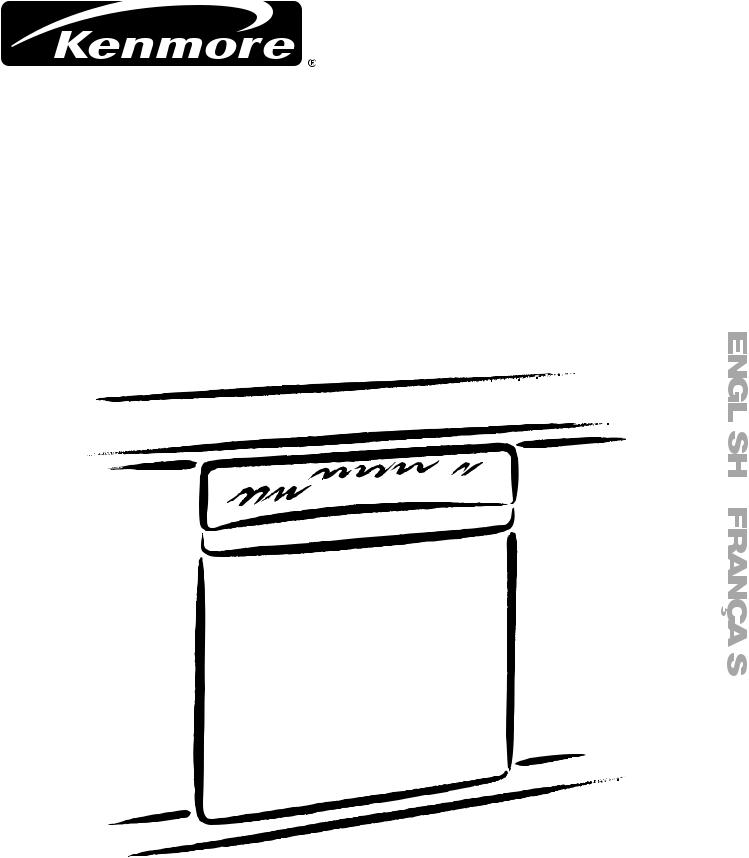
ULTRA WASH® Dishwasher
Use & Care Guide
Lave-vaisselle ULTRA WASH®
Guide d’utilisation et d’entretien
Models/Modèles 665.11072912, 665.11072913, 665.11072914, 665.11072922, 665.11072929, 665.11073912, 665.11073913, 665.11073914, 665.11073919
|
|
|
|
|
|
|
|
|
|
|
|
8542519 |
Sears Canada, Inc., Toronto, Ontario, Canada M5B 2B8 |
www.sears.ca |
|

TABLE OF CONTENTS
MAINTENANCE AGREEMENTS.................................................... |
2 |
WARRANTY..................................................................................... |
3 |
DISHWASHER SAFETY.................................................................. |
4 |
Before Using Your Dishwasher .................................................... |
5 |
PARTS AND FEATURES ................................................................ |
6 |
ULTRA WASH® Soil Removal System |
|
Featuring smartwash™ Sensing System................................... |
7 |
START-UP GUIDE .......................................................................... |
8 |
Using Your New Dishwasher........................................................ |
8 |
DISHWASHER LOADING.............................................................. |
8 |
Loading Suggestions.................................................................... |
8 |
Loading the Top Rack .................................................................. |
9 |
Loading Bottom Rack ............................................................... |
10 |
Loading Silverware Basket........................................................ |
10 |
DISHWASHER USE .................................................................... |
11 |
Detergent Dispenser.................................................................. |
11 |
Rinse Aid Dispenser .................................................................. |
12 |
Dishwasher Efficiency Tips ....................................................... |
12 |
Control Panel............................................................................. |
13 |
Cycle Selection Charts.............................................................. |
13 |
Canceling a Cycle...................................................................... |
14 |
Changing a Cycle or Setting ..................................................... |
14 |
Adding Items During a Cycle..................................................... |
14 |
Option Selections ...................................................................... |
15 |
Cycle Status Indicators ............................................................. |
16 |
Active Vent................................................................................. |
16 |
Drying System ........................................................................... |
16 |
Overfill Protection Float............................................................. |
16 |
WASHING SPECIAL ITEMS ........................................................ |
16 |
DISHWASHER CARE................................................................... |
17 |
Cleaning..................................................................................... |
17 |
Drain Air Gap ............................................................................. |
17 |
Storing ....................................................................................... |
17 |
TROUBLESHOOTING.................................................................. |
18 |
SERVICE NUMBERS ............................................... |
BACK COVER |
MAINTENANCE
AGREEMENTS
Your purchase has added value because you can depend on Sears HomeCentral® for service. With over 2,400 Service Technicians and access to over 900,000 parts and accessories, we have the tools, parts, knowledge and skills to back our pledge: We Service What We Sell.
Sears Maintenance Agreements
Your Kenmore® appliance is designed, manufactured and tested to provide years of dependable operation. Yet any major appliance may require service from time to time. The Sears Maintenance Agreement offers you an outstanding service program, affordably priced.
The Sears Maintenance Agreement
■Guarantees tomorrow’s service at today’s price.
■Eliminates repair bills resulting from normal wear and tear.
■Covers non-technical and instructional service calls.
■Provides an annual Preventive Maintenance Check, at your request, to ensure that your appliance is in proper running condition.
Some limitations apply. For information concerning Sears Home Central® Maintenance Agreements, call
1-800-361-6665.
2

WARRANTY
FULL ONE-YEAR WARRANTY ON THIS KENMORE ULTRA WASH® DISHWASHER
For one year from the date of purchase, when this dishwasher is installed and operated according to instructions provided in the Installation Instructions and Use & Care Guide, Sears will repair this dishwasher, free of charge, if defective in material or workmanship.
FULL TWO-YEAR WARRANTY ON ELECTRONIC CONTROL AND POWER SUPPLY BOARD
For two years from the date of purchase, when this dishwasher is installed and operated according to instructions provided in the Installation Instructions and Use & Care Guide, Sears will repair, free of charge, the electronic module and power supply board if defective in material or workmanship.
LIMITED TWO-YEAR WARRANTY ON THE ULTRA WASH® WASH SYSTEM
After the first year and until two years from the date of purchase, when the dishwasher is installed and operated in accordance with the instructions provided in the Installation Instructions and Use & Care Guide, Sears will replace any part of the
ULTRA WASH® wash system (motor, pump, spray arms,
ULTRA FLOW™ water feed tube, motor seals and pump gasket) due to defective materials or workmanship. Customer assumes any labor costs associated with replacement of these parts.
FULL WARRANTY FOR THE LIFE OF THE DISHWASHER, ON STAINLESS STEEL TUB MODELS, AGAINST LEAKS IN THE TUB AND INNER DOOR PANEL
For the life of the dishwasher, if a leak should occur as a result of rust-through of the stainless steel tub or inner door panel, Sears will replace free of charge the tub or inner door panel.
LIMITED FIVE-YEAR WARRANTY ON UPPER AND LOWER RACKS
After the first year and until five years from the date of purchase, when the dishwasher is installed and operated in accordance with the instructions provided in the Installation Instructions and Use & Care Guide, Sears will replace parts for the upper or lower dishrack if the rack rusts due to defective materials or workmanship. Customer assumes any labor costs associated with dishrack replacement.
WARRANTY RESTRICTION
If the dishwasher is subject to other than private family use, the above warranty coverage is effective for only 90 days.
WARRANTY SERVICE
WARRANTY SERVICE IS AVAILABLE BY CONTACTING THE NEAREST SEARS SERVICE CENTER IN CANADA. This warranty applies only while the product is in use in Canada.
This warranty gives you specific legal rights and you may also have other rights which vary from province to province.
For Sears Warranty information, please reference the service numbers located on the back page of this manual.
Sears Canada, Inc.
Toronto, Ontario, Canada M5B 2B8
PRODUCT RECORD
In the space below, record your complete model number, serial number, and purchase date. You can find this information on the model and serial number label, located as shown in the Parts and Features section of this book. Have this information available to help you quickly obtain assistance or service when you contact Sears concerning your appliance.
Model number 665.______________________________________________
Serial number___________________________________________________
Purchase date __________________________________________________
Save these instructions and your sales receipt for future reference.
3
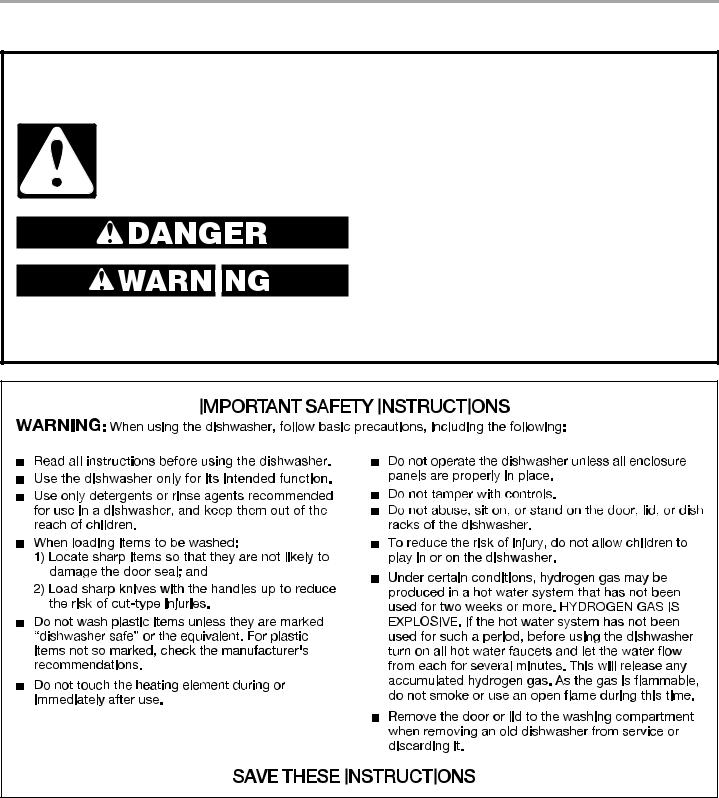
DISHWASHER SAFETY
Your safety and the safety of others are very important.
We have provided many important safety messages in this manual and on your appliance. Always read and obey all safety messages.
This is the safety alert symbol.
This symbol alerts you to potential hazards that can kill or hurt you and others.
All safety messages will follow the safety alert symbol and either the word “DANGER” or “WARNING.” These words mean:
You can be killed or seriously injured if you don't immediately follow instructions.
You can be killed or seriously injured if you don't follow instructions.
All safety messages will tell you what the potential hazard is, tell you how to reduce the chance of injury, and tell you what can happen if the instructions are not followed.
4
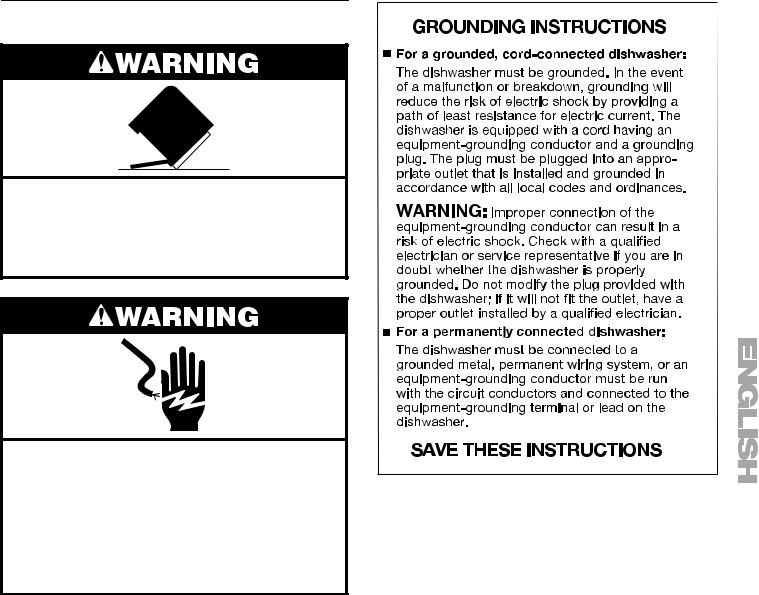
Before Using Your Dishwasher
Tip Over Hazard
Do not use dishwasher until completely installed.
Do not push down on open door.
Doing so can result in serious injury or cuts.
Electrical Shock Hazard
Electrically ground dishwasher.
Connect ground wire to green ground connector in terminal box.
Do not use an extension cord.
Failure to follow these instructions can result in death, fire, or electrical shock.
■Install where dishwasher is protected from the elements. Protect against freezing to avoid possible rupture of fill valve. Such ruptures are not covered by the warranty. See “Storing” in the “Dishwasher Care” section for winter storage information.
■Install and level dishwasher on a floor that will hold the weight, and in an area suitable for its size and use.
■Remove all shipping plugs from hoses and connectors (such as the cap on the drain outlet) before installing. See Installation Instructions for complete information.
5
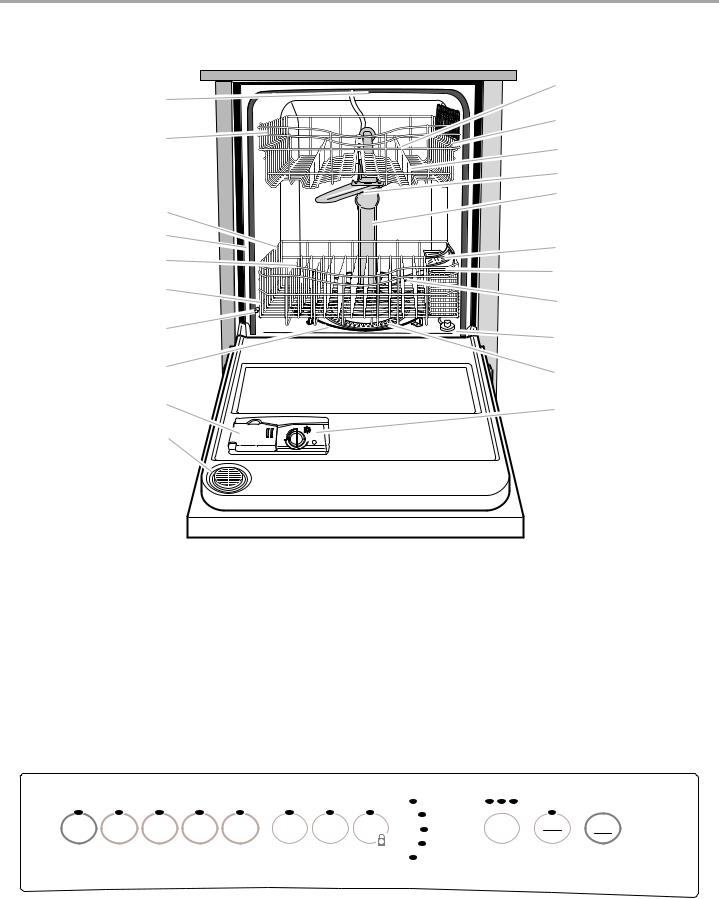
PARTS AND FEATURES
11
1
12
2
13
14
15
3 |
|
|
4 |
16 |
|
5 |
||
17 |
||
|
||
6 |
18 |
|
|
||
7 |
19 |
|
|
||
8 |
20 |
|
|
||
9 |
21 |
|
|
||
10 |
|
1. |
Upper level wash |
8. |
Heating element |
16. |
Silverware basket |
|
2. |
Top rack |
9. |
Detergent dispenser |
17. |
Silverware basket covers |
|
3. |
Bottom rack |
10. |
Active vent |
|
[on some models] |
|
18. |
Lower spray arm |
|||||
4. |
Model and serial number label |
11. |
Flexible tines |
|||
19. |
Overfill protection float |
|||||
5. |
Fold-down tines |
12. |
Cup shelves |
|||
20. |
ULTRA WASH® module |
|||||
6. |
Water inlet opening [in tub wall] |
13. |
No-flip clips [on some models] |
|||
21. |
Rinse aid dispenser |
|||||
7. |
Rack bumper |
14. |
Top spray arm |
|||
|
|
|||||
|
|
15. |
ULTRA FLOW™ water feed tube |
|
|
Control Panel
|
|
|
|
|
|
|
|
|
|
HOURS |
|
|
|
|
CYCLES |
|
|
|
OPTIONS |
|
WASHING |
2 |
4 |
8 |
|
|
|
|
|
|
|
|
|
|
|
|||
|
|
|
|
|
|
|
|
SENSING |
|
|
CANCEL |
|
SMART |
POTS |
NORMAL |
CHINA |
QUICK |
HI TEMP |
SANI |
AIR |
DRYING |
DELAY |
START |
||
WASH |
PANS |
WASH |
GENTLE |
RINSE |
SCRUB |
RINSE |
DRY |
|
HOURS |
DRAIN |
|
|
SANITIZED
LOCK ON
CLEAN
6

ULTRA WASH® Soil Removal System
Featuring smartwash™
Sensing System
The ULTRA WASH® Soil Removal System gives you sparkling clean dishes, while using less energy and time. The ULTRA WASH® Soil Removal System includes:
■A heavy-duty grinder that acts as a food disposer to grind and dispose of large food particles.
■An ULTRA WASH® sensor to monitor soil level and adjust the cycles as needed.
■An Automatic Temperature Control (ATC) that ensures the proper water temperature for the selected wash cycle and soil level of the load.
■A Triple Action Filtration system that intermittently filters soil from the wash water.
How the ULTRA WASH® Soil Removal System and the
Triple Action Filtration System work
1.Load the dishwasher. Remove bones, large chunks or burned-on food. No rinsing is necessary. Any remaining food soil will be ground up and disposed down the drain with the wash water.
2.After dishwasher starts, hot water fills the dishwasher to a level near the bottom of the overfill protection float.
3.When the wash cycle begins, the SENSING indicator glows and the soil level and water temperature are read.
4.The water drains at the end of the wash cycle or when high soil levels are sensed. Once drained, water fills again near the bottom of the overfill protection float.
5.As the main wash cycle begins, the SENSING indicator glows while the sensors measure soil load and temperature. Heat will be added during this period until the needed temperature is reached. The temperature needed depends on the cycle chosen and the soil level and dishload sensed.
6.Detergent is dispensed at the correct time in the cycle. The hot water and detergent spray against the soiled surfaces of the load and remove food particles.
7.Soils washed from the dishes are filtered from the wash water through the pump system. (See illustration below.)
2
1
3
8.Once soils collect in the filterbox, they will be sensed and purged. (See 3 above.) The soil is purged by removing only the soils and water in the filterbox. Only a small amount of hot water is removed from the wash cycle. Removing only soiled water conserves water and detergent.
9.The length of the main wash depends on the soil level sensed and the time needed to reach water temperature. The wash action will repeatedly pause for several seconds during this process.
10.Once the first rinse begins, fresh hot water enters the dishwasher and sprays onto the dishes. This rinse water is then pumped through the ULTRA WASH® Soil Removal System and remaining soil is removed.
11.The final rinse water is heated. The rinse aid is dispensed to the water for the final rinse to prepare the dishes for drying.
How the ULTRA WASH® Sensor and the Automatic Temperature Control (ATC) work
1.The SENSING indicator glows while the ULTRA WASH® Sensors detect the soil level or water temperature in the dishwasher.
2.After the soil level is determined, unnecessary portions of the cycle are skipped.
3.The ATC adjusts the water temperature throughout the cycle depending upon the soil level detected. Higher water temperatures are used to improve cleaning with heavier soiled loads.
How the smartwash™ Sensing System works
1.When the smartwash™ cycle is started, the SENSING indicator glows while the smartwash™ Sensors are detecting the amount of soil, water temperature, and the size of the dishload in the dishwasher.
2.After the soil level and dishload size are determined, the sensors automatically adjust the temperature and the amount of water used for the load. This allows less water usage when there is a smaller, less heavily-soiled dishload.
1.Soiled water flows into the pump.
2.The water is then pumped into the spray arms.
3.A portion of the pumped water is directed through the filterbox.
Water travels through this sytem continuously during both wash and rinse cycles.
7

START-UP GUIDE
Before using your dishwasher, remove all packaging materials. Read this entire Use and Care Guide. You will find important safety information and useful operating tips.
Using Your New Dishwasher
1.Scrape large food soil and hard items (toothpicks or bones) from dishes.
2.Properly load the dishwasher. (See “Dishwasher Loading.”) Make sure nothing prevents the spray arm(s) from spinning freely.
3.Add detergent and check the rinse aid dispenser. Add rinse aid if needed. (See “Dishwasher Use.”)
4.Push door firmly closed. The door latches automatically. Run hot water at the sink nearest your dishwasher until the water is hot. (See “Dishwasher Efficiency Tips.”) Turn off water.
5.Press the desired cycle and option selections. (See “Dishwasher Use.”) Press START. Or press START to repeat the same cycle and options as the previous cycle.
DISHWASHER
LOADING
Loading Suggestions
■Remove leftover food, bones, toothpicks and other hard items from the dishes. It is not necessary to rinse the dishes before putting them into the dishwasher.
NOTE: Dishes soiled with tomato-based products should be pre-rinsed to avoid staining.
The wash module removes food particles from the water. The module contains a chopping device which will reduce the size of food items.
NOTE: If hard items such as fruit seeds, nuts, and egg shells enter the wash module, you might hear chopping, grinding, crunching, or buzzing sounds. These sounds are normal when hard items enter the module. Do not let metallic items (such as pot handle screws) get into the wash module. Damage can occur.
■It is important for the water spray to reach all soiled surfaces.
■Load dishes so they are not stacked or overlapping, if possible. For best drying, water must be able to drain from all surfaces.
■Make sure pot lids and handles, pizza pans, cookie sheets, etc., do not interfere with the spray arm rotation.
■Run a rinse cycle to keep dishes moist if you do not plan to wash them soon. Foods such as eggs, rice, pasta, spinach, and cooked cereals may be hard to remove if they are left to dry over a period of time.
Quiet operating tips
To avoid thumping/clattering noises during operation:
■Make sure lightweight load items are secured in the racks.
■Make sure pot lids and handles, pizza pans, cookie sheets, etc., do not touch interior walls or interfere with the rotation of the spray arm.
■Load dishes so they do not touch one another.
NOTE: For built-in models, keep sink drain plugs closed during dishwasher operation to prevent noise transfer through drains.
8
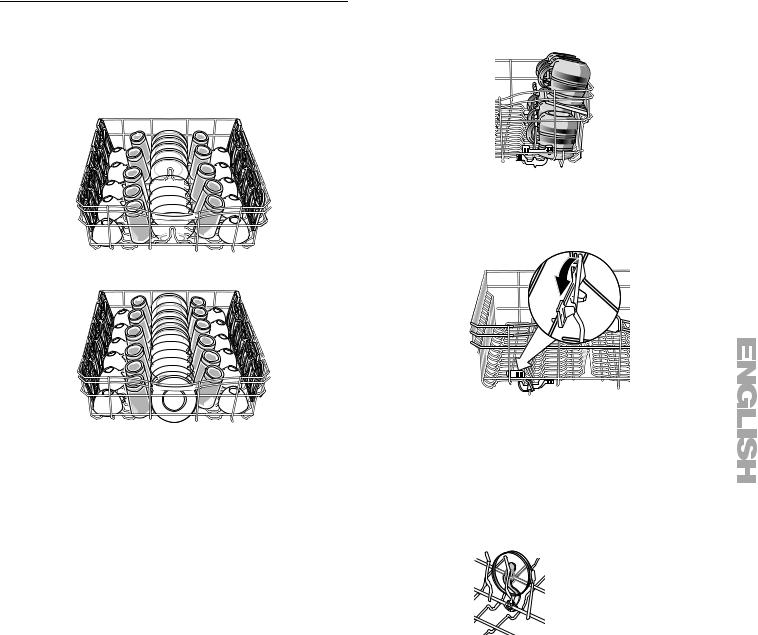
Loading the Top Rack
The top rack is designed for cups, glasses, and smaller items. Many items, up to 9 in. (22 cm), fit in the top rack. (See recommended loading patterns shown.)
NOTE: The features on your dishwasher rack may vary from the drawings shown.
10 place setting
12 place setting
■Place items so open ends face down for cleaning and draining.
■Load glasses in top rack only. The bottom rack is not designed for glasses. Damage can occur.
■Place cups and glasses in the rows between tines. Placing them over the tines can lead to breakage and water spots.
■China, crystal, and other delicate items must not touch each other during dishwasher operation. Damage may occur.
■Load lightweight plastic items in the top rack only. Only plastic items marked “dishwasher safe” are recommended.
■Load plastic items so the force of the spray does not move them during the cycle.
■To avoid chipping, do not let stemware touch other items.
■Small bowls, pans, and other utensils can be placed in the top rack. Load bowls in the center section for best stability.
Cup shelves
Fold down the extra shelves on the right side of the top rack to hold additional cups, or long items such as utensils and spatulas.
Flexible tines (on some models)
The row of tines on the left and right sides of the top rack can be adjusted to make room for a variety of dishes.
To adjust the flexible tines
1.Grasp the tip of the tine that is in the tine holder.
2.Gently push the tine out of the holder.
3.Lay the tines down, toward the center of the rack.
No-flip clips (on some models)
The no-flip clips hold lightweight plastic items such as cups, lids, or bowls in place during washing.
To move a clip
1.Pull the clip up and off the tine.
2.Reposition the clip on another tine.
9
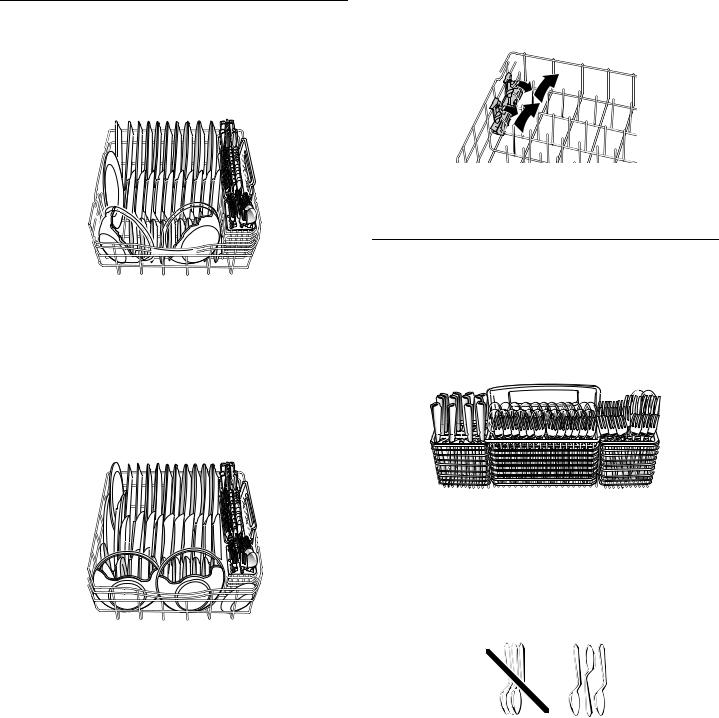
Loading Bottom Rack
The bottom rack is designed for plates, pans, casseroles, and utensils. Many items, up to 13 in. (33 cm) tall, fit in the bottom rack. (See recommended loading patterns shown.)
NOTE: The features on your dishwasher rack may vary from the drawings shown.
10 place setting
■Do not load glasses, cups, or lightweight plastic items in the bottom rack. Load small items in the bottom rack only if they are secured in place.
■Load plates, soup bowls, etc., between tines.
■Overlap the edges of plates for large loads.
■Load soup, cereal, and serving bowls in the rack in a variety of ways depending upon their size and shape. Load bowls securely between the rows of tines. Do not nest bowls because the spray will not reach all surfaces.
12 place setting
■Load cookie sheets, cake pans, and other large items at the sides and back. Loading such items in front can keep the water spray from reaching the detergent dispenser.
■Secure heavily soiled cookware face down in the rack.
■Make sure pot handles and other items do not stop rotation of the spray arm(s). The spray arm(s) must move freely.
■Do not load items between the bottom rack and the side of the dishwasher tub because they might block the water inlet opening.
NOTE: If you have removed the bottom rack for unloading or cleaning, replace it with the bumpers in front.
Fold-down tines
You can fold down one or both rows of tines at the back of the bottom rack.
1.Grasp the tip of the tine that is in the tine holder.
2.Gently pull the tine out of the tine holder.
3.Lay the row of tines down in the rack to make room for larger dishes, bowls, pots, pans or roasters.
Loading Silverware Basket
Load the silverware basket while it is in the bottom rack or take the basket out for loading on a counter or table.
NOTE: Unload or remove the basket before unloading the racks to avoid spilling water droplets on the silverware.
■Place small items such as baby bottle caps, jar lids, corncob holders, etc., in a covered section. Close the cover to hold small items in place.
■Use suggested loading patterns, as shown, to increase washability of your silverware.
■This silverware basket can be separated and placed into the bottom rack in several locations. Load silverware in all sections or just one, depending upon your load.
■If your silverware basket does not have covers or when covers are up, mix items in each section of the basket with some pointing up and some down to avoid nesting. Spray cannot reach nested items.
IMPORTANT: Always load sharp items (knives, skewers, etc.) pointing down.
10
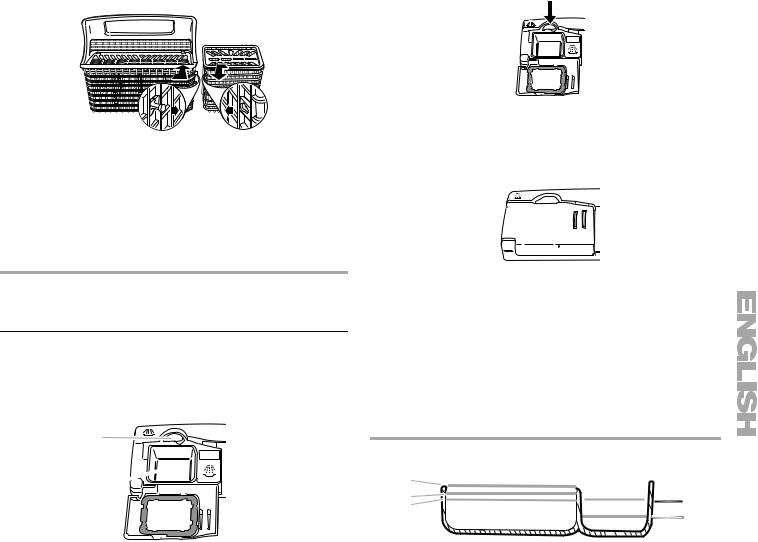
To remove a small basket
1.Hold the center basket and one small basket. Slide the small basket forward to release the tabs from the corresponding slots.
Filling the dispenser
1.If the dispenser cover is closed, open the cover by rotating the cover latch.
2. Pull the baskets apart.
NOTES:
■Do not load silver or silver-plated silverware with stainless steel. These metals can be damaged by contact with each other during washing.
■Some foods (such as salt, vinegar, milk products, fruit juices, etc.) can pit or corrode silverware. Run a rinse cycle if you do not have a full load to wash immediately.
DISHWASHER USE
Detergent Dispenser
The detergent dispenser has 2 sections. The smaller Pre-Wash section empties detergent into the dishwasher when you close the door.
1
 3
3
2 
 4
4
1.Cover latch
2.Main Wash section
3.Pre-Wash section
4.Cover
The larger Main Wash section automatically empties detergent into the dishwasher during the wash. (See the “Cycle Selection Charts.”)
■Use automatic dishwashing detergent only. Other detergents can produce excessive suds that can overflow out of the dishwasher and reduce washing performance.
■Add detergent just before starting cycle.
■Store tightly closed detergent in a cool, dry place. Fresh automatic dishwasher detergent results in better cleaning.
NOTE: Do not use detergent if you have selected a rinse cycle.
2.Fill the Main Wash section with detergent. See the following section “How much detergent to use.”
3.Fill the Pre-Wash section, if needed. (See “Cycle Selection Charts.”)
4.Close the dispenser cover.
The cover will open during the cycle to dispense the detergent.
How much detergent to use
■The amount of detergent to use depends on the hardness of your water and the type of detergent. If you use too little, dishes won’t be clean. If you use too much in soft water, glassware will etch.
■Water hardness can change over a period of time. Find out your water’s hardness by asking your local water department, water softener company, or county extension agent.
|
Main Wash section |
|
Pre-Wash section |
|
1 |
|
|
|
2 |
|
4 |
|
3 |
|
|
|
|
|
|
|
|
|
5 |
1. |
Use 8 tsp (40 mL) [full]) |
4. |
Use 4 tsp (20 mL) [full] |
2. |
Use 7 tsp (35 mL) |
5. |
Use 2 tsp (10 mL) |
3. |
Use 6 tsp (30 mL) |
|
|
NOTE: Fill amounts shown are for standard powdered detergent. Amounts may vary if you use liquid or concentrated powdered detergent. Tablet detergents should be placed in the main wash section of the detergent dispenser with the cover closed. Follow instructions on the package when using liquid dishwasher detergent, concentrated powdered detergent or tablet detergent.
IMPORTANT: See “Cycle Selection Charts” for which detergent dispenser sections to use with each cycle.
11
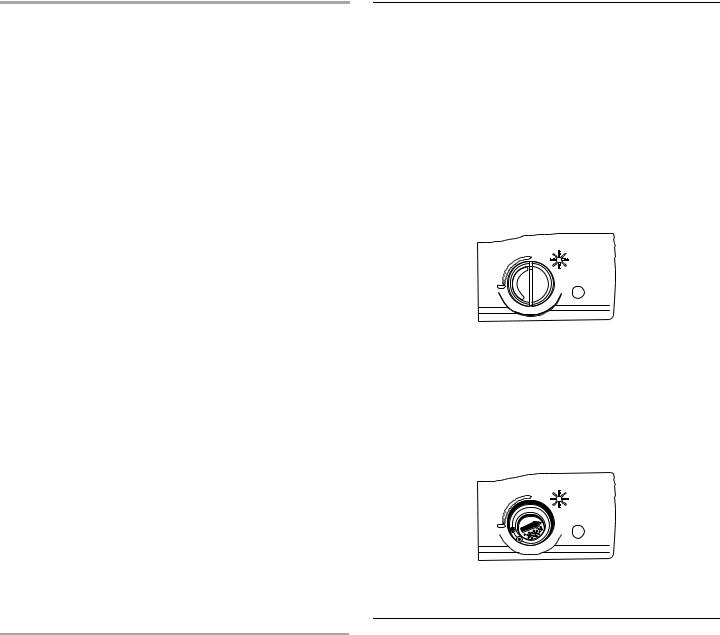
Soft Water (0-2 grains per gallon)
[typical water softener water]
Soil Level |
Main Wash section |
Pre-Wash section |
|
|
|
Lightly-soiled/Pre- |
6 tsp (30 mL) |
Empty |
rinsed dishloads |
|
|
|
|
|
Normally-soiled |
6 tsp (30 mL) |
2 tsp (10 mL) |
dishloads |
|
|
|
|
|
Heavily-soiled |
7 tsp (35 mL) |
4 tsp (20 mL) |
dishloads |
|
|
|
|
|
Medium Hard Water (2-6 grains per gallon)
[some city water]
Soil Level |
Main Wash section |
Pre-Wash section |
|
|
|
Lightly-soiled/Pre- |
6 tsp (30 mL) |
2 tsp (10 mL) |
rinsed dishloads |
|
|
|
|
|
Normally-soiled |
6 tsp (30 mL) |
4 tsp (20 mL) |
dishloads |
|
|
|
|
|
Heavily-soiled |
7 tsp (35 mL) |
4 tsp (20 mL) |
dishloads |
|
|
|
|
|
Hard Water (7-12 grains per gallon)
[well water and some city water]
Soil Level |
Main Wash section |
Pre-Wash section |
|
|
|
All soil types |
7 tsp (35 mL) |
4 tsp (20 mL) |
|
|
|
Very Hard Water (13 grains per gallon and above)† |
||
|
[hard well water] |
|
|
|
|
Soil Level |
Main Wash section |
Pre-Wash section |
|
|
|
All soil types |
8 tsp (40 mL) [full] |
4 tsp (20 mL) [full] |
|
|
|
†Turn the rinse aid dispenser to a higher setting as needed. (See “Rinse Aid Dispenser” section.) It might be necessary to use the Pots Pans or Normal cycle with the Hi Temp Scrub option for best wash performance in very hard water.
Rinse Aid Dispenser
Rinse aids prevent water from forming droplets that can dry as spots or streaks. They also improve drying by allowing water to drain off of the dishes during the final rinse by releasing a small amount of the rinse aid into the rinse water. Your dishwasher is designed to use a liquid rinse aid. Do not use a solid or bar-type.
Filling the dispenser
The rinse aid dispenser holds 4.8 oz (145 mL) of rinse aid. Under normal conditions, this will last for about three months. You do not have to wait until the dispenser is empty to refill it. Try to keep it full, but be careful not to overfill it.
1.Make sure the dishwasher door is fully open.
2.Turn the dispenser knob to the left and lift it out.
3.Add rinse aid until the indicator window looks full.
4.Clean up any spilled rinse aid with a damp cloth.
5.Replace the dispenser knob.
Rinse aid setting
The amount of rinse aid released into the final wash can be adjusted. The factory setting is at 2. For most water conditions set the adjuster to 1 or 2. If there are rings or calcium (hard water) spots on dishes, try a higher setting.
|
- |
- - 6 |
5 |
4 |
a |
x |
|
|
3 |
|
|
|
2 |
|
m |
|
|
|
1 |
To adjust the setting
Remove the dispenser knob, then turn the adjuster inside the dispenser to the desired setting.
Dishwasher Efficiency Tips
Hot water dissolves and activates the dishwashing detergent. Hot water also dissolves grease on dishes and helps glasses dry spot-free. For best dishwashing results, water should be 120°F (49°C) as it enters the dishwasher. Loads may not wash as well if the water temperature is too low. Water that is too hot can make some soils harder to remove and cause certain detergent ingredients not to function. If your water heater is located far from the dishwasher, it may be necessary to run the hot water at the faucet closest to the dishwasher to minimize the amount of cold water in the water line.
12
